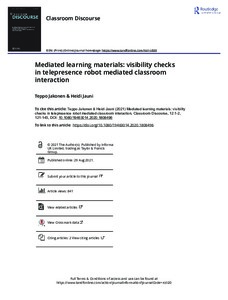Mediated learning materials: visibility checks in telepresence robot mediated classroom interaction
Jakonen Teppo; Jauni Heidi
Mediated learning materials: visibility checks in telepresence robot mediated classroom interaction
Jakonen Teppo
Jauni Heidi
ROUTLEDGE JOURNALS, TAYLOR & FRANCIS LTD
Julkaisun pysyvä osoite on:
https://urn.fi/URN:NBN:fi-fe2022021519198
https://urn.fi/URN:NBN:fi-fe2022021519198
Tiivistelmä
Videoconferencing is increasingly used in education as a way to support distance learning. This article contributes to the emerging interactional literature on video-mediated educational interaction by exploring how a telepresence robot is used to facilitate remote participation in university-level foreign language teaching. A telepresence robot differs from commonly used videoconferencing set-ups in that it allows mobility and remote camera control. A remote student can thus move a classroom-based robot from a distance in order to shift attention between people, objects and environmental structures during classroom activities. Using multimodal conversation analysis, we focus on how participants manage telepresent remote students' visual access to classroom learning materials. In particular, we show how visibility checks are accomplished as a sequential and embodied practice in interaction between physically dispersed participants. Moreover, we demonstrate how participants conduct interactional work to make learning materials visible to the remote student by showing them and guiding the 'seeing' of materials. The findings portray some ways in which participants in video-mediated interaction display sensitivity to the possibility of intersubjective trouble and the recipient's visual perspective. Besides increasing understanding of visual and interactional practices in technology-rich learning environments, the findings can be applied in the pedagogical design of such environments.
Kokoelmat
- Rinnakkaistallenteet [19207]
